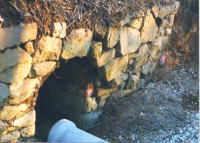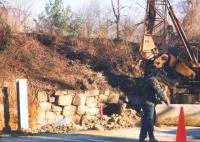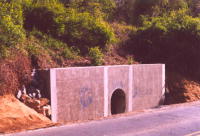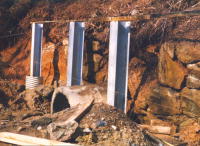|
|
|
Built by hand in the 1850's, this stone retaining wall has begun to bulge from the pressure of the earth on the trail above it. Click on photo to see detail. Before

|
 |
| Having stood for one-hundred and fifty years, the stone retaining wall has begun to bulge outward. Built by hand without mortar ("dry laid"), it is basically intact. Instead of reinforcing it, VDOT replaces it. |
|

|
 |
| Here the contractor is drilling holes for four posts which will support a new wall to be built in front of the existing wall. The heavy equipment has damaged the right side of the stone wall. But preserving the wall was never a goal of this work. |
|

|
 |
| A different angle. Below: the left-side of the wall is now destroyed, too. |
|
|
|
These photos show ugly the new concrete wall is compared to the old stone wall. It is too late now, but the stone wall could have been preserved.
After

|
 |
| Behind the wall, a culvert carries the water from Tripp's Run beneath the trail, just as it always carried Tripps Run beneath the railroad. The culvert is as old as the wall was (1850's). |
|

|
 |
| Graffiti now adorns the new wall. Appropriate, isn't it? |
|
Related Sites
Monocacy Aqueduct
The Monocacy Aqueduct Report by Carl Linden
The C&O Canal including other masonry structures, all protected in a national memorial

This page was last modified Apr. 28, 2000.
Back to the top |






